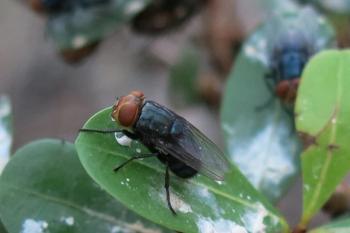
Incidences of neoplasia
Neoplasia is generally an uncommon occurrence in horses. "As a species, horses appear to have less of a predisposition to cancer," says John Robertson, VMD, PhD, director of the Center for Comparative Oncology at The Virginia-Maryland Regional College of Veterinary Medicine. "The overall incidence of neoplasms in horses is lower than in other long-lived species, i.e., humans, cats and dogs."
Neoplasia is generally an uncommon occurrence in horses. "As a species, horses appear to have less of a predisposition to cancer," says John Robertson, VMD, PhD, director of the Center for Comparative Oncology at The Virginia-Maryland Regional College of Veterinary Medicine. "The overall incidence of neoplasms in horses is lower than in other long-lived species, i.e., humans, cats and dogs."
Melanoma as parotid mass.
Though rare, several forms of cancer are found in equids, most commonly tumor types of the skin, including primarily melanomas in gray horses, equine sarcoids and squamous cell carcinomas.
Horses don't get many tumors, but it isn't because they don't live long enough to get them. They appear to be resistant to them as a species. The main target organ for neoplasia in the horse is the skin, and it is thought there are differences by breed and by pigmentation, just as there are in dogs.
At a recent AAEP session, one veterinarian noted that the answer to why horses rarely get cancer is that they are herbivores. "That's not a statement that can be backed up with published research results." Robertson says. "To counter that thought, by the age of 15, 80 percent of horses that have a pale pigmentation in their coat will have melanoma. We're talking about a significant number of animals. In fact, there may have been selection against the gray coat color based on an early recognition that melanoma might develop in these animals. This has been described in the literature for a couple-thousand years. The Romans actually recognized the fact that melanoma was out there. This is an old problem in search of modern answers."
Gross appearance of melanoma on intestinal tract at necropsy.
Though in relatively low incidence in horses compared to dogs, cats and cattle, it has been reported that 3 percent of horses presenting either for treatment of clinical disease or for necropsy had neoplasms of various organs and tissues. Cutaneous neoplasms are the most common type of equine tumors, accounting for 45 percent to 51 percent in some studies. In several studies of equine surgical biopsies, between 56 percent and 72 percent were sarcoids, melanomas or squamous cell carcinomas. The incidence of skin neoplasms in horses is very likely to be significantly higher than what is published in the veterinary literature because some of the most common tumors (melanomas, sarcoids) do not routinely undergo biopsy, sources say.
Of 3,115 equine admissions in 2005 that were diagnosed by biopsy, there were 15 squamous cell carcinomas, 11 melanomas, and two others, notes Sue Lindborg, veterinary technician at the University of Pennsylvania New Bolton Center.
We see relatively few numbers of cancer patients in the hospital, says Fairfield Bain, DVM, MBA, Dipl. ACVIM, ACVP, ACVECC, Hagyard Equine Medical Institute. "But I do have the opportunity to review biopsies from several patients from the field as well as the few we do see here in the hospital. Sarcoids represent the most common lesion through my biopsy service. Squamous cell carcinomas, usually involving the eyelids, nose or other non-pigmented area of skin, are next in frequency."
Peritoneal lipoma: The development of peritoneal lipomas can result in strangulation of bowel and the immediate need of surgical intervention.
Though Bain says he suspects melanomas are fairly common, his practice doesn't see a great deal, presumably because of their benign nature.
"Very rarely will we see a patient with nodular skin lesions that end up being cutaneous lymphoma," he says. "I have seen three adult mares over the past 10 years with this diagnosis, clinically presenting with widespread cutaneous nodules and plaques of varying size. Their clinical course waxed and waned for a period of time until the disease became more progressive. A rarely diagnosed skin tumor is a basal cell tumor fitting in the miscellaneous category. I can only recall seeing ovarian adenocarcinoma in one patient in the last 23 years."
In addition, Bain says he treats several patients each year with granulosa cell tumors.
Confluent infiltrative melanomas on the tail and perineum are one of the most common presentations of this neoplastic disease in pale-coated horses.
Squamous cell carcinomas
The type and number of equine oncology cases seen at the University of Florida (UF) College of Veterinary Medicine's Alec P. and Louise H. Courtelis Equine Hospital vary significantly and can be categorized based on location of the tumor, says Michael Porter, DVM, Ph.D. Dipl. ACVIM. By far, the most common category is cutaneous tumors, including squamous cell carcinomas (SCC), sarcoids, melanomas and papillomas. Typically, melanomas and papillomas do not present a problem to the equine patient and are merely noted on physical exam. However, on occasion, geriatric horses with clinical signs ranging from ataxia to recurrent colic that present with cutaneous melanomas might require a more extensive exam to determine the extent of melanoma formation.
As a referral institution, the cases presenting for primary evaluation of cutaneous tumors at UF typically have had some prior surgical/medical intervention by the referring veterinarian without complete resolution of tumor growth. The most common include SCC of the penis and the third eyelid.
Microscopic appearance of melanoma, showing variably pigmented polygonal cells.
"These conditions often require aggressive surgical debulking, such as penile amputation and complete eye removal," Porter says.
In addition, a variety of treatment modalities are provided, including surgical debulking, cryotherapy, intra-lesional chemotherapy injections and topical chemotherapy treatment.
"The incidence of SCC seems to be high in the state of Florida, and this may be due to the ideal environmental conditions," Porter says. "However, there is no definitive proof of this theory. My personal experience with treating SCC suggests that early and aggressive debulking followed by either topical or intra-lesional chemotherapy is critical for complete resolution of clinical signs."
Pythiosis is not a tumor but rather a granuloma that develops secondary to invasion of the soft tissues by the aquatic organisms Pythium spp.
Although rare, metastatic SCC does occur and usually results in the development of squamous cell carcinomas in the lungs. They have seen several such cases at the University of Florida that originally presented for a SCC on the penis.
Equally important to cases of SCC seen at UF, yet not metastatic, are sarcoids. These are considered the most common type of skin tumor in horses and can be locally aggressive. The majority of sarcoid cases that present to UF have been removed and/or topically treated at least once prior to their visit. However, due to their refractory and sometimes aggressive pattern of growth, sarcoids on some equine patients are referred for more aggressive treatment. "The university provides surgical debulking that often requires general anesthesia, cryotherapy and chemotherapy. Similar to SCC, sarcoids require early and aggressive treatment to reduce the likelihood of re-development," Porter says.
Skin tumor types
A variety of cutaneous neoplasms are seen in horses, with sarcoids, melanoma, squamous cell carcinoma and papilloma being most common. Seen less frequently are cutaneous lymphosarcoma, mastocytoma (mast-cell tumors), vascular tumors (hemangioma and hemangiosarcoma), keratoma and basal-cell tumors. Though the latter are less common, they still should be considered part of the differential diagnosis of skin masses and should be treated if identified.
Intestinal lymphoma: The spleen and GI tract appear to be most commonly affected by lymphoma, whereas the kidneys and stomach are common sites of adenocarcinoma.
Equine sarcoid
Equine sarcoids are the most common skin tumors seen in horses, mules and donkeys worldwide. The incidence ranges from 15 percent to 60 percent of skin tumors, typically seen on the extremities, head and ventral abdomen. In one study, 35 percent of 153 tumors occurred on the head, neck, eye and shoulder; 28 percent appeared on the hind legs; 24 percent manifested on the fore legs, and 12 percent appeared on the trunk. It has been noted that sarcoids can occur at sites of earlier trauma in some horses. Multiple lesions are common, but metastasis rare. Recurrence is common following surgical resection, occurring in about 30 percent to 50 percent of cases treated only with surgery.
Sarcoids occur in young horses, at less than 7 years of age; 70 percent occur in horses less than 4 years of age. They can occur in foals as young as 6 months. There is no sex or coat color predisposition. In one study, Quarter horses were found to be at twice the risk as Thoroughbreds, and Standardbreds were at half the risk of Thoroughbreds, but this suggested breed predisposition requires further study.
The most common cutaneous tumors include squamous cell carcinomas of the penis and the third eyelid. These conditions often require aggressive surgical debulking such as penile amputation and complete eye removal.
Sarcoids are of variable appearance, being flat, raised, sessile, pedunculated or verrucous, and they vary from 1 cm to more than 20 cm. They are firm, adherent to surrounding skin and underlying tissue and can be ulcerated. The rate of growth is highly variable, from very slow to very rapid. Lesions that ulcerate may form granulation tissue at the margins, increasing the size of the lesion and making it more likely to bleed when traumatized.
Despite their recognition for more than 90 years, the etiology of sarcoids is unknown. A virus has been suggested as the cause, but this has not been definitively proven.
Melanoma
The incidence of melanoma is 3 percent to 15 percent, based on biopsy and necropsy studies. The frequency of melanoma increases after age 6, and it is considered a somewhat inevitable occurrence in older gray and dilute-colored horses (approximately 80 percent of gray horses more 15 years old are susceptible), particularly Arabians and Percherons.
Early and aggressive debulking followed by either topical or intra-lesional chemotherapy is critical for complete resolution of clinical signs of squamous cell carcinomas.
The association of occurrence with dilute coat color is significant. In a study of 67 melanomas, only 30 percent were found in non-white/gray horses. Though associated with pale coat, that doesn't mean that those affected horses have a pale pigmentation in their skin.
"We've looked at that very extensively," Robertson says. "People have asked for a long time whether there is any relationship to exposure to sunlight, but we just don't know. We have started a project to try to figure that out by gathering statistical data from equine centers and agricultural and veterinary institutions around the world to find out in two breeds (Arabians and Thoroughbreds) whether, in fact, there is a difference based on ambient sunlight. We expect this study to take several years because the data that may help us is hard to pull together."
The common sites for primary melanomas include the under surface of the tail, perineum and the external genitalia. Other sites include the parotid lymph nodes, mammary gland, paralumbar and neck musculature, feet and legs, eye, mouth and vertebral column, but some of these can be metastatic. About 30 percent of melanomas are malignant, metastasizing/multicentric lesions when seen. Metastasizing lesions may be found throughout the body, including lymph nodes, body cavities, liver, kidney, heart and gastrointestinal tract. Melanosis of the parotid lymph nodes is a common finding in older gray/white horses and may be nidus for primary melanomas in this area. Clinical signs depend on the location of the tumor, rate of growth, and the amount and type of tissue compromised. Primary tumors can range from less than 1 cm to 20 cm and can be flat, raised, verrucous, pedunculated and ulcerated. There are several theories for pathogenesis of melanoma in horses, but there is no viable etiological explanation.
Despite the relatively low occurrence of neoplasia in equids, manifestations are a serious health threat.
"Right now we need to raise the bar so that equine practitioners and the general public understand that melanoma is a malignancy and not a benign thing, like a mole," he implores. "I routinely see horses that have the advanced stage of the disease. They are going to die from this disease, and we have very few treatments for it. We just need to recalibrate our thinking totally about what we are going to do for it."
The overall numbers of cases are low, but this may be an artifact of sampling. Most veterinarians in practice typically don't biopsy melanomas, so the number is likely to be substantially higher.
"The problem with diagnosing and understanding the actual incidence of melanoma in horses is that many veterinarians consider they are benign, common lesions in pale-coated horses, and they don't need to either biopsy them or to treat them," Robertson continues.
Increased surveillance, diagnosis and treatment could reduce the numbers of horses presented with non-treatable lesions; there is no convincing evidence that biopsy of melanomas causes them to spread, experts say.
Squamous cell carcinoma
Squamous cell carcinoma is very common in horses, usually found on the face, external genitalia and mucocutaneous junctions. Squamous cell carcinoma occurs commonly in skin lacking pigmentation, and this skin might be more susceptible to effects of solar radiation.
Squamous cell carcinomas are ulcerated, raised or verrucous, nodular growths ranging from 3 mm to more than 20 cm. The tumor is locally invasive and spreads readily to adjacent lymph nodes. Distant metastases occur but are uncommon. SCC in horses has less keratinization than that in dogs or cats, keratin pearls being infrequent. Secondary inflammation is common in ulcerated tumors.
Papilloma
Cutaneous papilloma of horses is a neoplastic disease induced by infection with the equine papilloma virus, a DNA-containing papovavirus. The tumors are most common on the muzzle and lips of horses ranging from age 1 to age 3. Single papillomas on the head or neck are occasionally seen in aborted fetuses and newborn foals. There is no breed or sex predisposition. Lesions may persist for one month to nine months, then spontaneously regress. Papillomas are irregularly shaped, multiple, discrete nodules, ranging from 2 mm to more than 1 cm, and they are gray, white or multicolored, and mottled.
Cutaneous lymphosarcoma
Lymphosarcoma is rare in horses. There are four forms — multicentric, alimentary, thymic and cutaneous. More common clinical signs include weight loss, fever, peripheral lymphadenopathy and anemia. Some horses show upper and lower respiratory disease. It occurs primarily in middle-aged mares (> 6 years of age), which present with a relatively short history, weeks to months, of growth of firm nodules on the head, neck and chest. Other clinical signs in these horses are variable but include anorexia, inability or unwillingness to work, depressed mentation, fever, dyspnea and weight loss. Some horses with primary cutaneous lymphosarcoma show no signs other than multiple, non-painful swellings in the skin or subcutis and peripheral lymphadenopathy.
Mastocytosis and mastocytoma
Mast-cell tumors are generally benign, solitary lesions of the skin and subcutis characterized histologically by sheets of mast cells. Mastocytoma is a benign neoplasm of horses between age 1 and age 18 with a mean age of 9.5 years. It is most often see in Arabians, with no sex predisposition. Tumors are commonest on the trunk and head, less so on the neck and extremities. Gross lesions range from 3 mm to 8 cm in diameter, average 3.5 cm. The majority are firm, tan and raised cutaneous nodules. Surface ulceration and foci of caseous debris are seen. After surgical removal, there is no recurrence in about 90 percent of the cases, followed for six years or more. Metastasis is uncommon.
Clinically they occur predominantly in males at a mean age of 7.7 years. Nodules develop over weeks to months. There is no breed predisposition. Most tumors are on the head, neck and chest, and they range from 1 cm to 20 cm. In most cases, they are solitary nodules with aggregates of mast cells in the dermis and subcutis and occasional extensions into underlying musculature.
Keratoma
Keratoma has been seen in the hooves of horses for many years. Microscopically they consist of cores of mature keratin and debris surrounded by a rim of neoplastic squamous epithelium. Inflammation, secondary infection and necrosis are common. Surgical excision is curative with a one-year follow-up.
Hemangiomatosis
Cutaneous hemangioma and hemangiosarcoma are often found in horses 1 year of age and younger, but they also have been seen in horses 8.5 to 13 years of age. Lesions are most common on the head, neck and extremities. Grossly, lesions range from 1.5 cm to 31 cm, and most are ulcerated and bleed easily. These cancers are seen primarily in Arabians, but also in Thoroughbreds, Quarter horses and Appaloosas, among others.
Basal-cell tumors
Basal-cell tumors are benign cutaneous neoplasms of basal epidermal layers and adnexa (hair follicles, cutaneous glands). Although such skin tumors are common in dogs and cats, they are rare in horses. The age range of affected horses is 4 to 20 years with a mean age of 10.6 years. There is no breed predisposition.
Newsletter
From exam room tips to practice management insights, get trusted veterinary news delivered straight to your inbox—subscribe to dvm360.






